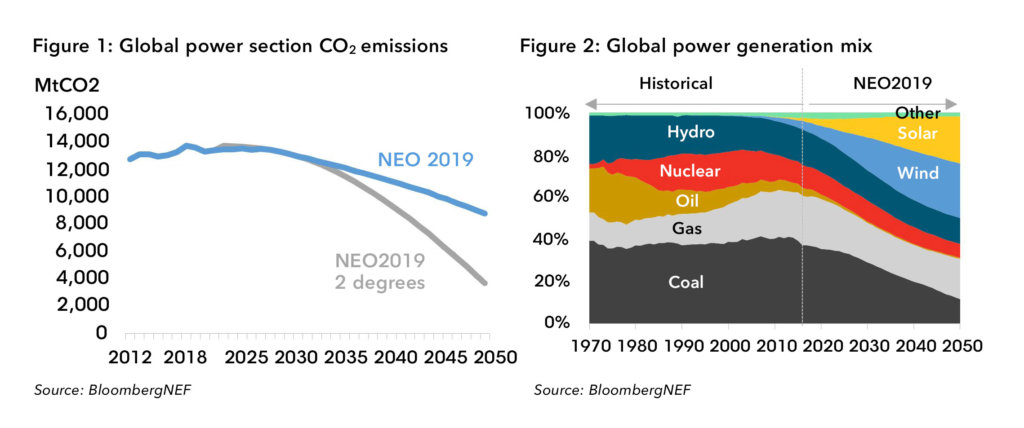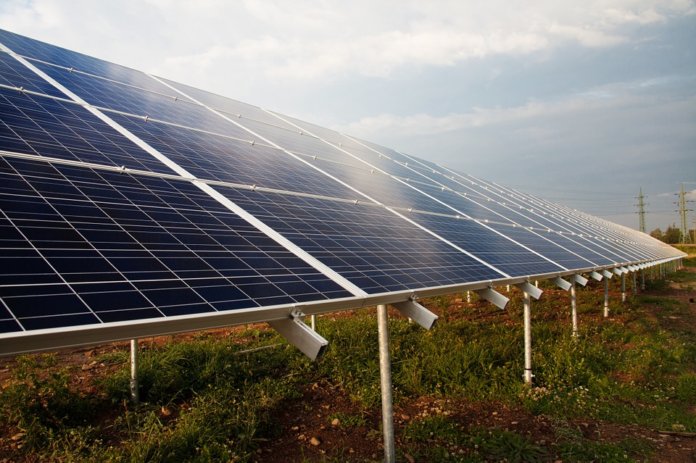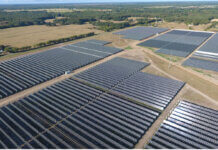Deep declines in wind, solar and battery technology costs could result in a grid powered nearly 50% by the two fast-growing renewable energy sources by 2050, according to the latest projections from BloombergNEF (BNEF).
In its New Energy Outlook 2019 (NEO), BNEF sees these technologies ensuring that – at least until 2030 – the power sector contributes its share toward keeping global temperatures from rising more than 2 degrees Celsius. Importantly, however, major progress in decarbonization will also be required in other segments of the world’s economy to address climate change, BNEF notes.
Each year, NEO compares the costs of competing energy technologies through a levelized cost of energy analysis. This year, the report finds that in approximately two-thirds of the world, wind or solar now represent the least expensive option for adding new power-generating capacity. Electricity demand is set to increase 62%, resulting in global generating capacity almost tripling between 2018 and 2050. This will attract $13.3 trillion in new investment, of which wind will take $5.3 trillion and solar $4.2 trillion. In addition to the spending on new generating plants, $840 billion will go to batteries and $11.4 trillion to grid expansion, BNEF predicts.
NEO starts by analyzing technology trends and fuel prices to build a least-cost view of the changing electricity sector. The results show coal’s role in the global power mix falling from 37% today to 12% by 2050 while oil as a power-generating source is virtually eliminated. Wind and solar grow from 7% of generation today to 48% by 2050, and the contributions of hydro, natural gas and nuclear remain roughly level on a percentage basis.

“Our power system analysis reinforces a key message from previous New Energy Outlooks – that solar photovoltaic modules, wind turbines and lithium-ion batteries are set to continue on aggressive cost reduction curves of 28 percent, 14 percent and 18 percent, respectively, for every doubling in global installed capacity,” says Matthias Kimmel, NEO 2019 lead analyst. “By 2030, the energy generated or stored and dispatched by these three technologies will undercut electricity generated by existing coal and gas plants almost everywhere.”
According to BNEF, the projected growth of renewables through 2030 indicates that many nations can follow a path for the next decade and a half that is compatible with keeping the increase in world temperatures to 2 degrees or less. And they can do this without introducing additional direct subsidies for existing technologies such as solar and wind.
“The days when direct supports, such as feed-in tariffs, are needed are coming to an end,” says Elena Giannakopoulou, head of energy economics at BNEF. “Still, to achieve this level of transition and decarbonization, other policy changes will be required – namely, the reforming of power markets to ensure wind, solar and batteries are remunerated properly for their contributions to the grid. NEO is fundamentally policy-agnostic, but it does assume that markets operate rationally and fairly to allow lowest-cost providers to win.”
According to the report, Europe will decarbonize its grid the fastest, with 92% of its electricity supplied by renewables in 2050. Major Western European economies in particular are already on a trajectory to significantly decarbonize, thanks to carbon pricing and strong policy support. The U.S., with its abundance of low-priced natural gas, and China, with its modern fleet of coal-fired plants, follow at a slower pace.
China sees its power sector emissions peaking in 2026 and then falling by more than half in the next 20 years. Asia’s electricity demand will more than double to 2050. At $5.8 trillion, the whole Asia Pacific region will account for almost half of all new capital spent globally to meet that rising demand. China and India together are a $4.3 trillion investment opportunity, and the U.S. will see $1.1 trillion invested in new power capacity, with renewables more than doubling their generation share to 43% in 2050, predicts BNEF.
The outlook for global emissions and keeping temperature increases to 2 degrees or less is mixed, according to this year’s NEO. On the one hand, the build-out of solar, wind and batteries will put the world on a path that is compatible with these objectives at least until 2030. On the other hand, a lot more will need to be done beyond that date to keep the world on that 2 degree path.
According to BNEF, one reason is that wind and solar will be capable of reaching 80% of the electricity generation mix in a number of countries by mid-century (with the help of batteries), but going beyond that will be difficult and will require other technologies to play a part – with nuclear, biogas-to-power, green hydrogen-to-power, and carbon capture and storage among the contenders.
BNEF’s NEO director, Seb Henbest, says, “Our analysis suggests that governments need to do two separate things – one is to ensure their markets are friendly to the expansion of low-cost wind, solar and batteries, and the other is to back research and early deployment of these other technologies so that they can be harnessed at scale from the 2030s onwards.”
NEO 2019 is the result of a detailed study of the outlook for energy demand and supply, country-by-country, conducted by 65 BNEF analysts around the world. More on the report can be found here.





While we are building out our renewable hopes on the situation as it is now, why are we not discussing the growing threat of cyberattacks on the heavily centralized grid we have and why we ought to be primarily moving toward greater decentralization of the technologies best suited for such a move? Amory and Hunter Lovins suggested decentralization as far back as 1982 in Brittle Power. Cyberattacks are not science fiction anymore, people.
Joel Gordes
Energy & Environmental Security Strategies
This prediction is ridiculously conservative. If technological advance were linear, this prediction MIGHT be true. But, technological advance has been exponential for solar and batteries for over 65 years, and shows no sign of slowing soon. Presuming it only continues the historical pace (no sudden breakthrough), solar and batteries will become so cheap that fossil fuel plants will not be able to compete by 2035. By 2050, we will be carbon neutral with respect to “burning stuff for energy,” and Global Greening will be mopping up the extra CO2 for free.